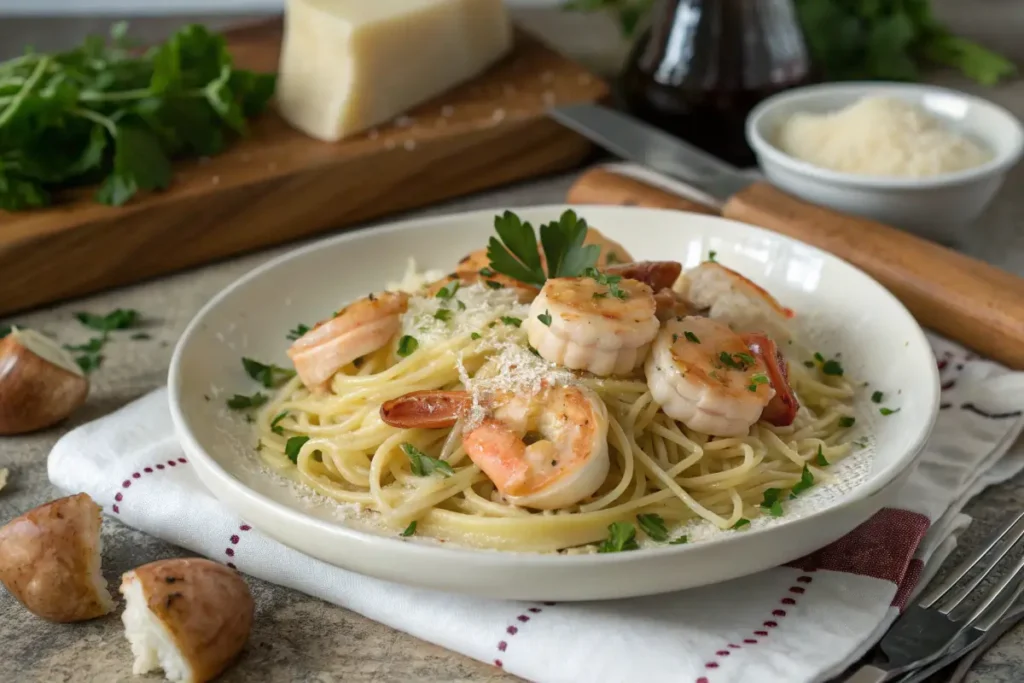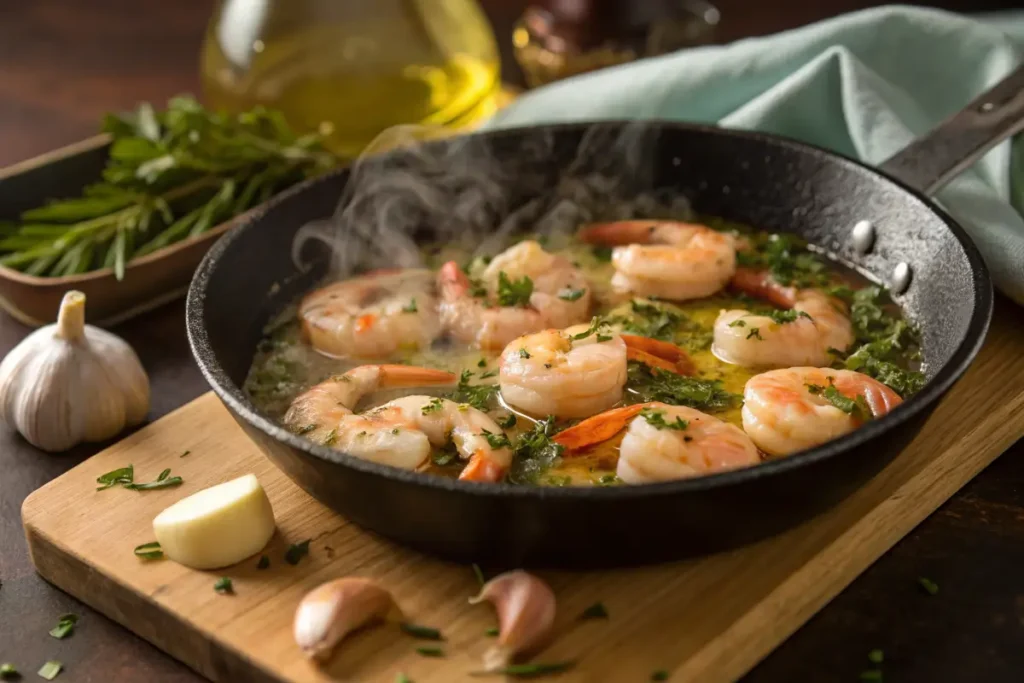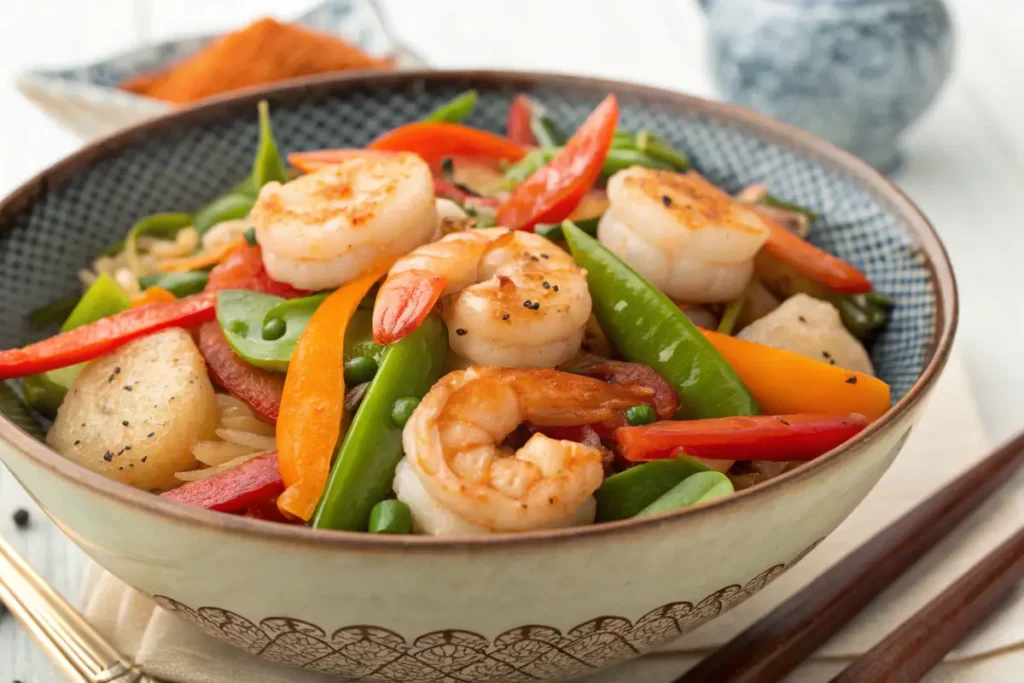Shrimp and scallops are two of the most popular seafood choices worldwide, beloved for their delicate flavors and versatility in a wide range of dishes. Whether you’re a fan of savory shrimp pasta, succulent grilled scallops, or a delightful combination of both, there’s no denying the appeal of these ocean treasures. In this article, we’ll dive into the health benefits, nutritional facts, cooking tips, and even address common myths surrounding shrimp and scallops. We’ll also compare the two to help you make the best choice for your next meal. Plus, we’ll share some tasty recipes and give insights into sustainable seafood practices. So, let’s get started!
Introduction to Shrimp and Scallops
What Are Shrimp and Scallops?
Shrimp and scallops are both types of shellfish but come from different families of the ocean. Shrimp are small, elongated crustaceans, commonly found in both saltwater and freshwater. They are a versatile ingredient in many cuisines, often served in everything from salads to stir-fries. On the other hand, scallops are a type of bivalve mollusk, typically found in the deep ocean. They are known for their round, fan-shaped shells and are often harvested for their tender, sweet meat.
Both shrimp and scallops have been part of human diets for thousands of years, making them favorites in both fine dining and casual meals. These two seafood items are often enjoyed in tandem, especially in dishes where their textures and flavors complement each other beautifully.
Why Choose Shrimp and Scallops?
There are many reasons to include shrimp and scallops in your diet. First and foremost, they are packed with high-quality protein and offer a range of essential nutrients like omega-3 fatty acids, vitamins, and minerals. They’re also a great option for those seeking low-calorie, low-fat foods that are filling and nutritious. Additionally, shrimp and scallops can be easily incorporated into various dishes, offering a delightful contrast in texture and taste when combined.
Beyond their nutritional benefits, these seafood choices are incredibly versatile in the kitchen. Whether you’re looking to whip up a quick seafood stir-fry or prepare an elegant seafood platter, shrimp and scallops are perfect for all skill levels. Let’s now explore their many health benefits in the next section.
Health Benefits of Shrimp and Scallops
Nutritional Value of Shrimp and Scallops
When it comes to nutritious seafood, both shrimp and scallops stand out as excellent options. These two shellfish are rich in protein, offering a healthy dose of essential nutrients without being high in fat or calories. A 3-ounce serving of shrimp provides around 20 grams of protein, making it a fantastic choice for those seeking lean, muscle-building options. Likewise, scallops are packed with protein, offering a mild yet flavorful seafood choice that’s perfect for a low-calorie diet.
Beyond protein, shrimp and scallops are loaded with vital vitamins and minerals. Shrimp, for instance, contains a good amount of vitamin B12, an essential nutrient that plays a role in nerve function and red blood cell formation. Scallops, on the other hand, provide significant amounts of magnesium, which is necessary for muscle function and overall heart health.
In addition, both shrimp and scallops are rich in omega-3 fatty acids, which support cardiovascular health and reduce inflammation. Including them in your diet can help improve cholesterol levels and reduce the risk of heart disease. And if you’re looking to improve your bone health, both types of seafood also offer a good amount of phosphorus, which helps build and maintain strong bones.
Health Benefits of Eating Shrimp and Scallops
Eating shrimp and scallops regularly offers a range of health benefits that extend far beyond their delicious taste. First, they’re fantastic for heart health due to their omega-3 content. Studies have shown that omega-3s help lower blood pressure, reduce triglycerides, and prevent the formation of harmful blood clots. In fact, individuals who include seafood in their diets tend to have a lower risk of cardiovascular diseases.
Both shrimp and scallops are also packed with antioxidants, such as selenium, which help protect cells from oxidative stress and support the immune system. These antioxidants can reduce the risk of chronic diseases, including cancer.
Moreover, shrimp and scallops are naturally low in calories, making them an excellent option for those looking to maintain a healthy weight. They’re filling and nutritious without contributing excessive calories, which is a win for anyone watching their diet.
Incorporating shrimp and scallops into your meals can improve your overall health by enhancing your nutrient intake while supporting various bodily functions.
Shrimp vs. Scallops: Which Is Better ?
Shrimp Benefits vs. Scallop Benefits
Both shrimp and scallops offer excellent health benefits, but they differ in certain aspects. When comparing shrimp and scallops, the key lies in their protein and fat content. Shrimp tends to be slightly lower in fat, making it a fantastic option for those seeking to reduce calorie intake. Scallops, however, contain slightly more fat, though they are still a lean protein source. Therefore, if you’re looking for a lower-fat option, shrimp might be the better choice.
In terms of taste, shrimp has a firmer texture with a slightly sweet flavor, while scallops are more tender with a delicate, almost buttery taste. Both are versatile in the kitchen, but if you prefer a dish with more bite, shrimp may be a better option, especially in stir-fries or pasta dishes. On the other hand, scallops shine when lightly seared or grilled, offering a melt-in-your-mouth texture.
Taste and Texture Differences
The taste and texture of shrimp and scallops also play a role in deciding which one suits your meal better. Shrimp’s texture is denser, with a chewiness that makes it suitable for grilling, boiling, or frying. It pairs wonderfully with bold seasonings and sauces, which bring out its rich flavor.
Scallops, on the other hand, have a more delicate texture. They’re much softer and cook quickly, so they’re ideal for dishes where you want a sweet, tender bite. They absorb flavors beautifully and are often paired with light herbs or citrus to highlight their natural sweetness. If you’re preparing a gourmet meal or seafood platter, scallops tend to be the star of the show due to their refined taste and melt-in-the-mouth texture.
While both shrimp and scallops have their unique characteristics, the choice between the two largely depends on your taste preferences and the type of dish you’re preparing.
Popular Shrimp and Scallop Recipes
Shrimp and Scallop Pasta: A Delicious Combination
One of the best ways to enjoy shrimp and scallops is by pairing them in a flavorful pasta dish. A classic shrimp and scallop pasta combines these two shellfish in a creamy sauce with garlic, butter, and a touch of white wine. You can add a squeeze of lemon for a refreshing citrus burst that complements the sweet and tender meat of the shrimp and scallops.

To make this recipe, start by sautéing garlic and shallots in butter, then add the shrimp and scallops, cooking them until they’re just tender. After removing the shellfish, create a rich sauce with white wine, cream, and a dash of Parmesan. Toss the pasta in the sauce, ensuring it’s coated evenly, and finish with a sprinkle of fresh parsley. This dish is perfect for a special dinner or even a quick weekday meal.
If you’re a fan of seafood pasta, you can explore variations by adding vegetables like spinach or sun-dried tomatoes for extra texture and flavor. The beauty of this dish lies in its versatility—whether you prefer a richer sauce or a lighter, olive oil-based one, shrimp and scallops will always steal the show.
Grilled Shrimp and Scallop Skewers Recipe
For a fun and interactive meal, grilled shrimp and scallop skewers are always a hit. These skewers are perfect for outdoor barbecues or a simple weeknight dinner. To make them, alternate shrimp and scallops on wooden skewers, then brush them with a marinade made of olive oil, lemon juice, garlic, and herbs like thyme or rosemary. Let the skewers marinate for at least 30 minutes before grilling.
Grill the skewers for about 2-3 minutes on each side, until the shrimp turns pink and the scallops are golden brown. For added flavor, you can also brush the skewers with a glaze made of honey and soy sauce during the grilling process.
These skewers are ideal when served with a side of rice or a fresh salad, and they offer a wonderful combination of smoky, sweet, and savory flavors that highlight the natural sweetness of the shrimp and scallops.
For more delicious seafood recipes, check out our Chicken and Shrimp Recipes article.
How to Cook Shrimp and Scallops Perfectly
The Best Cooking Techniques for Shrimp
Cooking shrimp to perfection requires a few simple techniques. The key to perfectly cooked shrimp is ensuring they don’t overcook, as they can turn rubbery if left on the heat too long. Start by peeling and deveining the shrimp, leaving the tails on for a more elegant presentation. You can cook shrimp by grilling, sautéing, or even boiling them.
When grilling shrimp, it’s important to marinate them beforehand to infuse flavor. For sautéing, heat olive oil or butter in a pan and cook the shrimp for 2-3 minutes per side. Keep an eye on them as they cook—shrimp will turn pink and opaque when done.
One of the most foolproof ways to cook shrimp is by steaming them. Simply place them in a steam basket over boiling water for 3-4 minutes, and they’ll be cooked through without losing their delicate texture.

Perfectly Cooked Scallops: Tips and Tricks
Scallops, with their tender and delicate nature, require a more gentle cooking method. The best way to cook scallops is by searing them in a hot pan for 1-2 minutes per side. Before cooking, ensure the scallops are thoroughly dry to get a crispy golden crust. Season them lightly with salt and pepper, then cook them in a hot skillet with a bit of butter or oil.
You can also bake scallops, especially when preparing them with a crust or topping. Baking at 375°F for about 10-12 minutes will yield perfectly tender scallops that melt in your mouth.
The secret to both shrimp and scallops is timing—too little, and they’re undercooked; too much, and they’re rubbery. Follow these simple steps to make sure your shrimp and scallops are cooked just right every time.
Environmental Impact of Shrimp and Scallop Farming
Sustainable Shrimp Farming Practices
When it comes to seafood, sustainability is an important factor to consider. Overfishing and unsustainable farming practices can harm marine ecosystems, but fortunately, there are efforts to make shrimp and scallop farming more sustainable. Shrimp farming, in particular, has a history of environmental concerns, including the destruction of mangroves and pollution. However, modern practices are shifting toward more eco-friendly methods.
One way to ensure sustainability is by choosing shrimp farmed in systems that reduce environmental impact, such as recirculating aquaculture systems (RAS). These closed systems filter and recycle water, minimizing waste and reducing the need for chemicals. Additionally, farmed shrimp raised without antibiotics or harmful chemicals are better for both the environment and your health.
Another sustainable practice involves farming shrimp in certified organic environments, where the use of harmful pesticides and fertilizers is restricted. Certification bodies such as the Aquaculture Stewardship Council (ASC) and Best Aquaculture Practices (BAP) are helping to set standards that promote better environmental practices.
How to Choose Sustainably Sourced Shrimp and Scallops
When purchasing shrimp and scallops, it’s essential to make informed decisions about sourcing. Look for labels that indicate sustainability, such as Marine Stewardship Council (MSC) for wild-caught shrimp or Aquaculture Stewardship Council for farmed shrimp. These certifications ensure that the seafood was sourced with attention to environmental and social impacts.
For scallops, it’s important to buy from fisheries that follow sustainable harvesting practices. Scallop harvesting involves dredging, which can sometimes damage the ocean floor. Sustainable practices involve using more eco-friendly methods, like hand-harvesting or dredging with minimal environmental impact. Always check for certifications such as MSC to verify that the scallops you’re purchasing come from sustainable sources.
By choosing sustainably sourced shrimp and scallops, you’re making a positive impact on marine ecosystems while supporting responsible farming and fishing practices.
Shrimp and Scallops in Different Cuisines
Shrimp and Scallops in Mediterranean Cuisine
Mediterranean cuisine is known for its fresh ingredients and bold flavors, and shrimp and scallops are often featured in these dishes. The Mediterranean diet emphasizes healthy fats, vegetables, and lean proteins, making shrimp and scallops perfect for this type of cuisine.
In Mediterranean dishes, shrimp and scallops are frequently grilled or roasted, seasoned with olive oil, garlic, lemon, and fresh herbs like parsley and oregano. For example, a popular dish is shrimp saganaki, a Greek dish made with shrimp cooked in a rich tomato sauce with feta cheese and olive oil. Scallops can be seared with a simple garlic-butter sauce and served with a side of roasted vegetables or a fresh salad.
Shrimp and scallops are also commonly used in Mediterranean seafood pasta dishes. The combination of seafood, pasta, and light sauces made from olive oil, lemon, and white wine creates a flavorful yet healthy meal that perfectly captures the Mediterranean spirit.
Shrimp and Scallops in Asian Cuisine
Asian cuisine, particularly in countries like Thailand, Japan, and China, also makes great use of shrimp and scallops. In these dishes, the natural sweetness of the shrimp and scallops pairs beautifully with bold, savory flavors.
For instance, in Thai cuisine, shrimp is commonly used in Tom Yum soup, a tangy and spicy broth made with lemongrass, lime, chili, and fish sauce. Scallops are also used in stir-fries, often combined with vegetables and flavored with soy sauce, ginger, and garlic. In Japan, shrimp tempura is a popular dish where shrimp is battered and fried, creating a crispy texture that contrasts nicely with the sweet shrimp inside.
Asian cooking methods like steaming, stir-frying, and grilling bring out the best in shrimp and scallops, offering a variety of ways to enjoy these versatile seafood options. With their delicate flavors, shrimp and scallops lend themselves to many Asian-inspired dishes, offering a delightful fusion of textures and tastes.

Common Myths and Facts About Shrimp and Scallops
Common Myths About Shrimp
There are many misconceptions about shrimp that can make people hesitant to include them in their meals. One common myth is that shrimp is high in cholesterol and bad for heart health. While it’s true that shrimp contains cholesterol, it is low in saturated fat, which has a much stronger impact on heart health. In fact, shrimp is considered heart-healthy due to its high levels of omega-3 fatty acids, which can help reduce the risk of heart disease.
Another myth is that farmed shrimp is harmful to the environment. While some shrimp farming practices have been unsustainable, there are now more eco-friendly options available, such as those using recirculating aquaculture systems (RAS). Always look for certifications like ASC or BAP to ensure you’re choosing sustainably farmed shrimp.
Debunking Scallop Myths
Similarly, scallops are often misunderstood. One myth is that all scallops are the same, whether they are wild-caught or farmed. While both types are delicious, wild-caught scallops often have a better flavor and texture. Farmed scallops are becoming more common and are also a sustainable option when harvested responsibly.
Another myth surrounding scallops is that they are difficult to cook. In reality, scallops are very easy to prepare. They cook quickly and can be seared, grilled, or baked, offering a tender and sweet flavor that enhances many dishes. The key is to avoid overcooking them to ensure they maintain their delicate texture.
FAQs About Shrimp and Scallops
Can I Eat Shrimp and Scallops if I Have Allergies?
If you have a shellfish allergy, it’s important to avoid shrimp and scallops, as they belong to the same family of shellfish that can trigger allergic reactions. However, if you’re unsure about an allergy or sensitivity, it’s always best to consult with your healthcare provider to determine whether these seafood options are safe for you to eat.
Are Shrimp and Scallops Safe to Eat During Pregnancy?
Both shrimp and scallops are safe to eat during pregnancy as long as they are cooked properly. It’s important to avoid raw or undercooked shellfish to reduce the risk of foodborne illnesses. When cooked thoroughly, shrimp and scallops can provide essential nutrients like protein and omega-3 fatty acids, which are beneficial for both mother and baby.
What’s the Best Way to Store Shrimp and Scallops?
To keep your shrimp and scallops fresh, store them in the coldest part of your refrigerator if you plan to use them within 1-2 days. If you’re not going to eat them right away, it’s best to freeze them. Place shrimp and scallops in airtight containers or freezer bags to prevent freezer burn. Make sure to thaw them in the refrigerator before cooking for the best texture and flavor.
How Can I Tell if Shrimp and Scallops Are Fresh?
Fresh shrimp should have a firm texture, a translucent appearance, and a mild ocean-like smell. If they have a strong, unpleasant odor or appear slimy, they may not be fresh. Scallops should have a sweet aroma and a firm, moist texture. If they appear dry or have a strong fishy smell, they may be past their prime.

